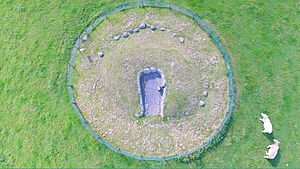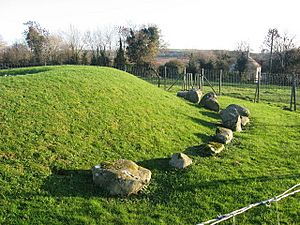Townleyhall passage grave facts for kids
|
Tuama Pasáiste Halla an Toinlígh
|
|

Townleyhall Tomb from the air
|
|
| Location | valley of the River Boyne |
|---|---|
| Region | County Louth, Ireland |
| Coordinates | 53°43′16″N 6°27′05″W / 53.721150°N 6.451253°W |
| Type | chamber tomb |
| Part of | Brú na Bóinne |
| History | |
| Periods | Neolithic |
| Type | Cultural |
| Criteria | i, iii, iv |
| Designated | 1993 (17th session) |
| Part of | Brú na Bóinne - Archaeological Ensemble of the Bend of the Boyne |
| Reference no. | 659 |
| Ireland | |
| Region | Europe and North America |
Townleyhall passage grave is an ancient burial place in Ireland. It's a special type of tomb called a chamber tomb, found about 2 kilometers north of the famous Dowth tomb. This site is part of a much larger group of ancient stone structures known as Brú na Bóinne in County Louth, Ireland.
Even though it's not as famous as some of its neighbours, Townleyhall is a very important part of Ireland's history. It is located just inside the "buffer zone" of the World Heritage Site. This means it's close to the main protected area, but not right in the center.
Exploring Townleyhall Tomb
Townleyhall is a fascinating place that tells us about people who lived a very long time ago. It started as a place where people lived during the Neolithic period, also known as the New Stone Age. This was a time when people first started farming and building large stone monuments.
What is a Passage Tomb?
A passage tomb is an ancient burial monument. It has a long, narrow entrance passage that leads to a central burial chamber. These tombs were built by people in the Stone Age to bury their dead. They often contain the remains of many people.
Townleyhall is a bit different from other famous tombs in the Boyne valley. It has a single room that connects directly to the entrance passage. This means there isn't a separate, distinct chamber at the end. It's like walking straight into the main room without any turns.
Uncovering the Past: The Excavation
Townleyhall was carefully dug up by an archaeologist named George Eogan in 1962. This work was very important for understanding ancient Ireland. During the excavation, archaeologists found pieces of pottery called Carrowkeel ware.
Finding this pottery was a big deal! It was the first clear sign that Ireland's passage graves were built during the Neolithic period. Before this discovery, experts weren't completely sure how old these amazing stone structures were. After Townleyhall, many other ancient sites in the area were also excavated. The methods used back then were simpler than what archaeologists use today, but they still helped us learn a lot.



